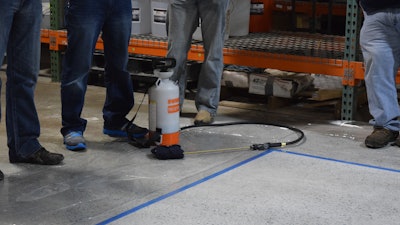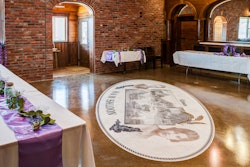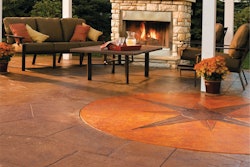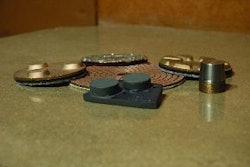
There are a variety of ways concrete dyes can be applied, depending on the size of the job and the desired end result. Typically a HVLP (high-volume low-pressure) sprayer is the best applicator.
Remove all dust and debris from the floor so you are working with a relatively clean surface. Use an auto-scrubber for best results. It is best to apply concrete dyes around the 200 grit-honing step for dense/harder concrete or 400 grit for porous/softer concrete when use in a concrete polishing process. It is also important to test in a small inconspicuous area first to ensure the dye is producing the desired result. All concrete surfaces are different and the color can change depending on the age of the concrete, the base tint or shade of gray of the slab to be dyed as well as many other factors.
Concrete dyes are available in a few different forms but the most popular are powdered dyes and concentrated colorant. Powdered dyes are solvent-based and acetone is most often used for mixing with the powdered dye. Concentrated colorant concrete dyes are liquid-based and water or acetone can be used for mixing. Both produce relatively the same result, however familiarity with the product is important as well as the specifications of the project. Solvents are sometimes restricted depending on the project’s environment.
 When applying dye use a HVLP sprayer and make sure to do circular motions about the size of a basketball with the sprayer wand.
When applying dye use a HVLP sprayer and make sure to do circular motions about the size of a basketball with the sprayer wand.
Mixing the dye is simple. Put the concrete powder or liquid concentrate into a gallon or five gallon container, shake vigorously and let it emulsify for five to 10 minutes for the liquid concentrate. The powder dyes need about two to three hours to fully dissolve in the acetone before applying. Once mixed, simply pump the sprayer to add the pressure needed to spray the dye onto the concrete surface. Fan tips are not recommended as they tend to leave lines in the floor. Conical tips like the Grey - Patriot tip will give a more uniform pattern and help achieve the recommended 400-600 square feet per gallon coverage rate.
When applying the dye make sure to do circular motions about the size of a basketball with the sprayer wand. Also be sure the surrounding areas and walls are covered appropriately. Water-based dyes need about 30 minutes to dry while acetone has a faster flash time and is ready almost immediately.
Once you have achieved uniform coverage and the concrete dye has had time to dry the next step is to densify the floor.”This method of densifying immediately after applying concrete dyes without removing the residual dye is relatively new. This method uses the residual dye to penetrate deeper into the floor for a more vibrant end result. It also saves on “clean up” labor time since removing the residual dye is no longer required.
Continue honing and polishing to the level required. The final step is applying a concrete sealer for protection.
About the author
Dustin Thomas is the Director of Marketing at Ameripolish.



















